
25 minute read
Breeding
by AgriHQ
Using the laws of nature
Ged Goode and Harry Mowbray are two men on a mission. A mission to increase their farms efficiency and create a system that will continue long-term.
Goode and Mowbray are partners in Hartwood Farms near Tokoroa, Waikato. The farm, which was originally converted to an organic farm 12 years ago, has since begun creating a farming system designed to get the most out of nature.
This meant Goode and Mowbray having to undergo extensive research and stripping back what is currently perceived as normal or known to how the environment is naturally developed to deal with many different obstacles dairy farmers face on a daily basis.
Studying pasture growth and natural cycles has empowered them to embed biodiverse systems into this unique dairy farming system. Some of these systems have required a change in the status quo attitude to how they graze pasture and last year alone, Hartwood Farms planted 6000 fruit trees on the farm. The fruit trees attract different kinds of bugs that go into the natural life cycle of the farm and provide valuable shelter and shade for the animals. While this process has been long and hard, the farm performance is proving itself worth the investment.
As part of their research into the benefits of biodiversity, they have also been focusing on the genetics of his herd. Firstly focusing on A2A2 and the polled gene, last year they raised 250 calves and only nine needed to be disbudded.
During their focus into the herd’s genetics, Goode and Mowbray weren’t surprised to find the benefits of crossbreeding and more importantly the Three Way Cross and its performance in various farms around the world. The key benefit of a Three Way Cross is the staggering 86% continuous heterosis (hybrid vigor) you can achieve once the cross is stabilised.
Heterosis was one draw for Hartwood Farms looking at the Three Way Cross, however, when investigating further they found all of the other incredibly efficient benefits of using specially selected breeds in the Three Way Cross.
When selecting intended breeds they looked at feed conversion efficiencies, the CLA gene (immune boosting), A2A2, polled and the breeds potential for dual purpose.
The Future of Efficiency is an animal that can combine all of these factors, produce high-component dairy products, a high-valued beef calf (rather than a bobby calf) and have superior health traits and immunity.
We have produced a farming system here that is sustainable and will be here for a very long time.
Goode and Mowbray are confident that many of these techniques are the direction the industry needs to take to secure the future of a sustainable dairy industry.
Three-way-cross genetics are being used on Hartwood Farms in Waikato to breed efficient cows to ensure future sustainability.
Samen’s Three Way Cross breed has 86% continuous heterosis or hybrid vigor, as well as other benefits.
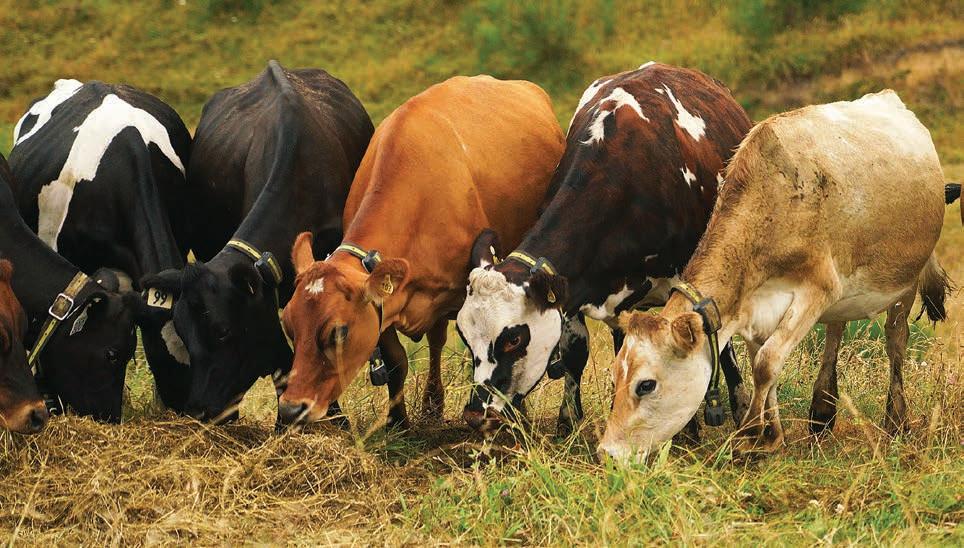
LIC senior reproduction solutions advisor Jair Mandriaza says body condition and nutrition is one of eight key areas of focus to improve repro on-farm.
Breeding goals
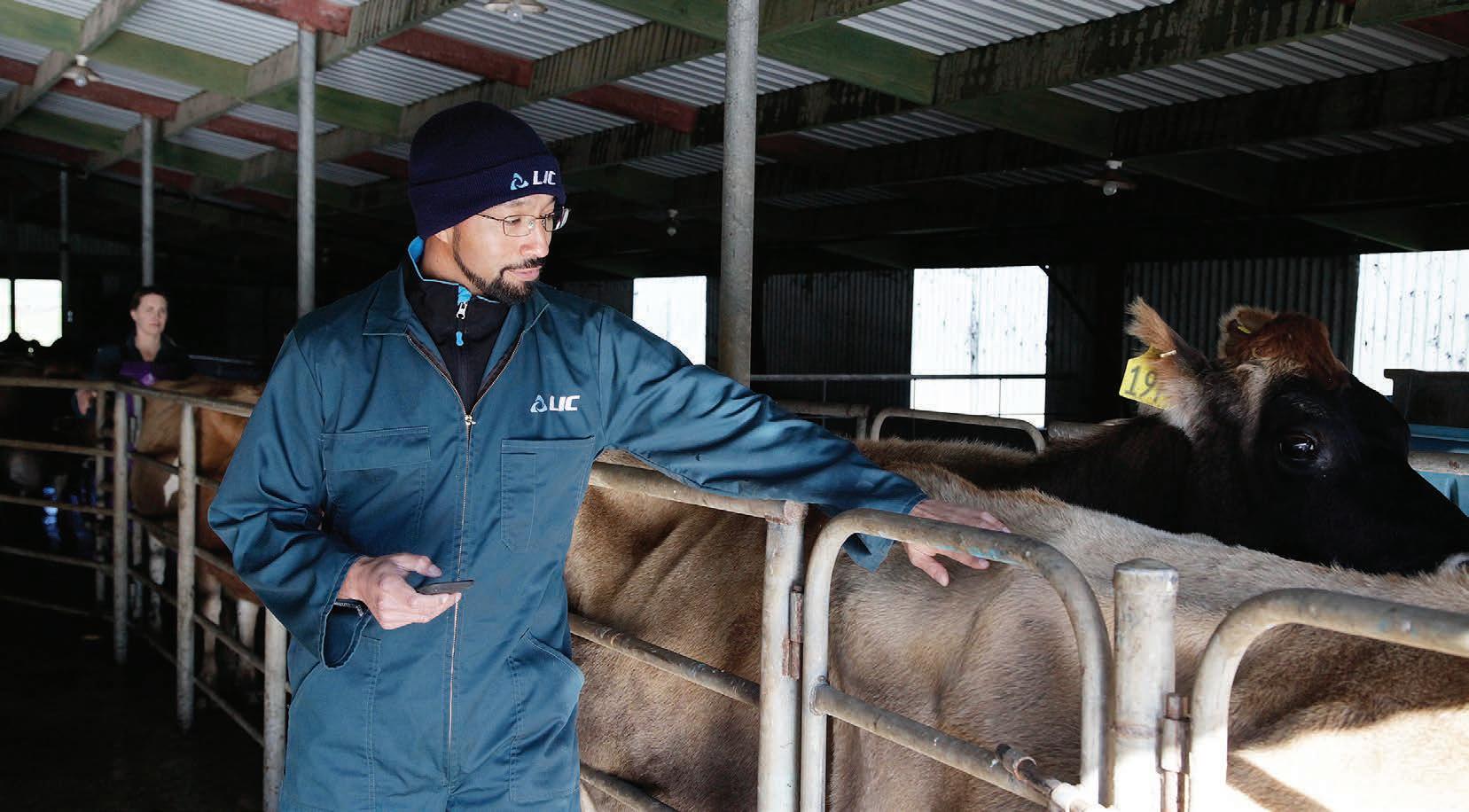
By Samantha Tennent
When it comes to breeding a top herd, there is no one-sizefits-all and plans should be tailored to suit the farm and herd.
There is no such thing as a standard breeding plan template because every farm and every farmer is different. To determine the right approach for your farm this breeding season, there are a series of questions to initially work through.
At some recent SMASH field days LIC senior reproduction solutions advisor Jair Mandriaza spoke about achieving your herd goals by developing the right breeding plan, making the right culling decisions and having good reproductive management.
“The principles of herd improvement include what cows you keep, what bulls you use and what calves you rear, and reproduction is the foundation for everything,” Mandriaza says.
“Semen sales show crossbred is the most popular breed we have at LIC, with Holstein-Friesian not far behind. Whatever type of cows you choose – black and white, brown or black – you can have whatever you want, as long as you can get cows pregnant.
“And when designing a breeding plan, farmers firstly need to consider where they are on their journey, what their reproductive performance is like and what systems they have in place to manage their breeding programme.”
Nationally, the trend for reproductive performance hit a high in 2012 only to go backwards alongside the dairy downturn to a low point in 2016, before climbing again to a high of 67.8% in 2019. This is still a far cry from the target of 78%, which the herds in the top quartile for reproductive performance achieve.
“Having better performance gives farmers more options, and we see that farmers performing in the top quartile have shorter mating lengths and lower not-in-calf rates,” he says.
Mandriaza says there is a significant correlation with six-week in-calf rates and not-in-calf rates because the more cows that get in calf early, there are fewer empty cows at the end of mating.
Technologies have developed over the years and farmers have an array of possibilities to formulate their individual breeding plans. From conventional semen, to sexed semen, short-gestation semen and beef semen, there are many considerations for each and it is important to think about how many replacements are needed.
“If a farm is struggling with their reproductive performance, they could complicate things further by adding something like sexed semen, which can have a reduced conception rate,” he says.
“And when looking at options for using beef semen and possibly reducing bobby calves, farmers need to consider if they have a market for the calves and if they have the facilities to house large numbers.
Artificially inseminating yearlings can be attractive for genetic gain, but it is important to check whether the heifers have grown well enough, whether the grazier is on board and if sufficient facilities are available.
“It is also worth considering if there are sufficient systems in place to manage using different types of semen at once for specific cows or groups of cows, and what mitigations could help things run smoothly during mating,” he says.
Mandriaza recommends working with your herd advisors, veterinarians and farm consultants to assess your current performance and help formulate the best plan for your herd. He advocates for utilising tools like the DairyNZ InCalf Fertility Focus Report and the InCalf book to identify where the opportunities lie.
“At the end of the day it’s not about having the plan itself, it’s about having the herd that allows you to deliver what you want, and they need to be getting in calf well to allow that,” he says. n
Setting up a fertile herd
DairyNZ-led research confirms the Fertility Breeding Value (BV) may contribute more to reproductive performance than originally thought.
Unreliable cows that don’t get in calf easily each season create stress and rob farmers of profit. All farmers want cows that produce well, get back in calf, and remain in the herd as long as possible.
That’s becoming more achievable onfarm, thanks to recent research findings from the Pillars of a New Dairy System programme*.
Fertility findings
Pillars has uncovered the significance of the Fertility BV in contributing to reproductive performance. Our measure of reproductive performance, the six-week in-calf rate, is driven by cows being submitted and conceiving in the first three weeks of mating. Trial work
KEY POINTS
• Genetics is only one of eight key management areas of reproduction. • Know your herd’s current Fertility BV status before planning your breeding programme. • Use your support network to assess your herd and plan for improvement. demonstrated that animals with higher Fertility BVs started cycling sooner and had higher submission rates, giving them more opportunity to get in calf.
What does this mean for your herd?
The trial compared cows with extremes of high (+5) and low (-5) Fertility BV, which you won’t see on a typical farm. The trial isolated the BV to understand how it impacts a cow’s reproductive performance. The current average Fertility BV for a New Zealand cow is 0.5; we’d consider any herd with an average Fertility BV below this to be low.
To find out your herd’s Fertility BV, request a Herd BV Averages report from your herd improvement company. Compare the figure for your mixed-age cows with your younger animals. We want to see the Fertility BV trending upwards in the younger animals, indicating progress.
If your herd’s Fertility BV is below average and/or is lower in younger animals, you may want to emphasise fertility in your breeding goals.
Also consider your herd’s current reproductive performance. The NZ average for six-week in-calf rate sits around 67%, compared with the industry target of 78%. Herds with lower performance will see more impact from improving a low herd Fertility BV than a herd with above-average performance. “Trial work demonstrated that animals with higher Fertility BVs started cycling sooner and had higher submission rates, giving them more opportunity to get in calf.”
Choosing bull teams
When selecting your mating programme, take all your breeding goals into account. Using an automated team of bulls from your breeding company can be sufficient, but it pays to compare your herd’s BVs with the proposed bull teams’ BVs.
The best way to control the genetic improvement of your herd is by nominating bulls. Select bulls with as high a Fertility BV as possible, without compromising too much on your other breeding goals. n
MORE:
Funded by dairy farmers through the milksolids levy and by the Ministry of Business, Innovation and Employment (MBIE). For more information dairynz.co.nz/ pillars
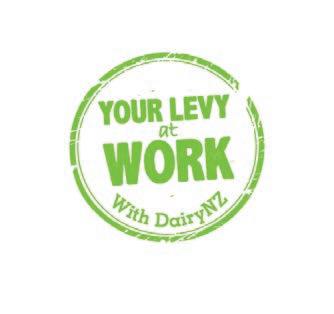
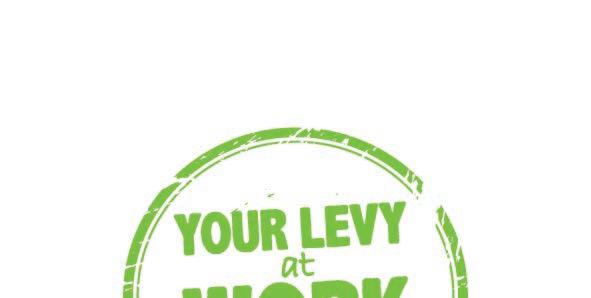
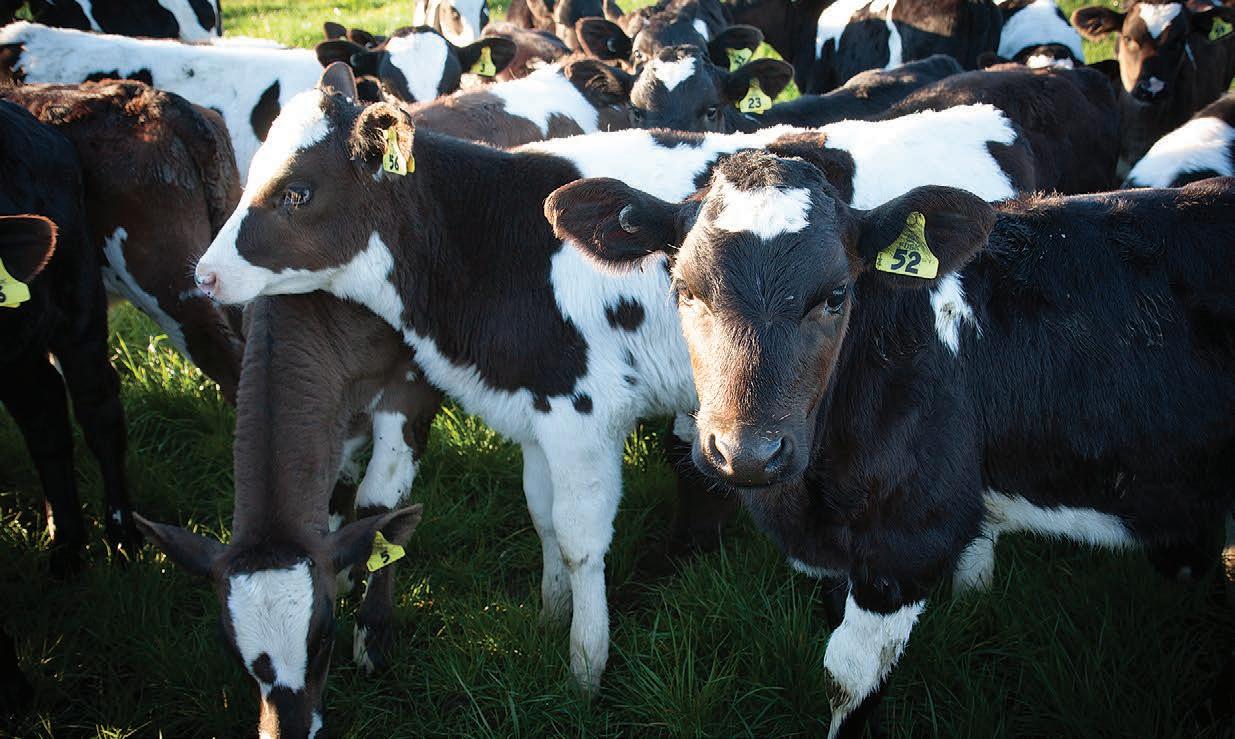
with DairyNZ
When selecting a mating programme, take breeding goals into account and select high breeding value bulls to ensure genetic gains in your herd.
Fit for the job
By Samantha Tennent
When selecting cows for showing, breeding plays a big part in searching for ones to put their best hoof forward.
Cattle showing in New Zealand is a small industry, and the number of people who can fit cattle in preparation for shows is even smaller. The closed borders exacerbates the situation further, which has left fitter Braydon Schroder run off his feet with requests this season.
“I was fitting so many cows at the NZ Dairy Event (NZDE) this year, I was working nearly 22 hours a day,” Schroder says.
“It takes a bit of skill to prepare an animal, particularly clipping them properly to show off their strengths and hide some of their weaknesses. The preparation is a niche skillset and there aren’t many people in NZ who do it.”
When he is not behind the clippers he is a farm consultant for Perrin Ag based in Rotorua with clients across the North Island, and in his spare time he trips around the countryside fitting cattle, which has also taken him around the world.
While fitting cattle for show is a big part of showing, breeding plays a big part too.
“At the end of the day, the only factor that has any influence is the confirmation of the cow and how the fitter/handler has presented her on the day,” he says.
As well as showing, Schroder has judged shows and says as a judge he looks for what cow is the strongest and shows the most dairy quality. It also has to be balanced throughout and portray longevity in a milking herd.
“I look and judge on leg structure, correct rump and shoulder angles, width, length and depth of the cow throughout, and strong udder attachments and teat placement, udder texture, bone quality and more,” he says.
“It is hard to find the perfect cow but generally, I picture it in my mind when judging certain aspects of a cow. Although, any cow should be looked at as a full package.”
Schroder has a keen interest in breeding and several years ago while in Australia, bought Paringa Beemer Opaque calf, which he says has an “amazing bloodline”.
“It was through a scholarship from the Holstein Friesian Association I got to travel to Australia. I spent about five weeks touring, staying on host farms and getting a feel for their showing and dairy industry,” he says.
Towards the end of his trip he went to a sale and got sucked in by a calf after seeing the dam in the stalls.
“I had gotten close to one of my host families and I managed to persuade them to form a partnership to buy the calf,” he says.
“The plan was they would feed and milk her, we would split breeding costs and progeny, and I’d come back to show her.
“And the day after we bought the calf, her dam Paringa Fever Opa won Australia’s International Dairy Week, so her value went up immensely.
“Opa’s strengths were she had practically no faults, an incredibly strong udder attachments and a smaller very balanced frame to her.”
Schroder showed Opaque as a yearling and she won all her classes in the smaller shows and came second in Australia’s second biggest Holstein show. The plan was to get her out last year in her prime as a four-year-old, but covid-19 put a damper on it.
“Hopefully, I will get a chance to get her out this year, but it was really disappointing as she was looking amazing last year and we had spent a lot of time and money getting her prepared,” he says.
Schroder says when it comes to breeding, his decisions depend on what goals are with that specific cow.
“I have a few that are commercial pets where I breed them for milk production and health traits, alongside selecting bulls that will fix any specific fault these cows may have in their confirmation,” he says.
“For my more valuable cows that are

Preparing and showing cattle kept Braydon Schroder busy at the NZ Dairy Event in Feilding earlier this year. Photo: Renae Flett
worth more to show breeders, the priority of this breeding is using well known or the latest high-type bulls internationally wanted by the show market.
“Alongside this, I select a specific bull that will improve parts of the confirmation that the specific cow being bred mostly needs.
“This is why being able to break down the confirmation of a cow (judge cows) is important, so that we are selecting the correct bulls to breed with the right cows to improve the longevity, performance and quality of our industry’s herd.”
He grew up on a Holstein Friesian stud in Tararua where he had plenty of opportunities to show cattle and as he got older and refined his skills overseas, he became sought-after by other keen show-goers.
“It started with showing my own animals at calf club and pet days, then evolved into A & P shows and onto things like Dairy Event when I was younger,” he says.
During university he did an exchange in Canada for six months. He attended Guelph University and explored local showing scenes, and fitted for wellknown cattle breeders while touring the country.
“I learnt heaps about clipping and preparing cattle in Canada. I got to prepare stock for previous winners of the Canadian Royal and Dairy Expo,” he says.
“There was so much work that I easily could’ve stayed and made fitting a full-time gig. The showing industry in Canada and the United States is huge; we are so small here in NZ, with Australia being between the two really.”
Although cattle fitting is just a hobby, the long hours he puts in are paid well and he enjoys being part of the process.
“How much I do depends on how experienced the owner is – essentially I can do as little or as much as a breeder wants,” he says.
“We discuss feeding in the weeks, or even months, beforehand and those few days before the show I could be washing, clipping, prepping tops, training some to lead and defining milking hours.”
He says milking each quarter of the cow at a certain time will help the udder look its best come judging, as it can look fuller with correct structure.
Although he has a competitive nature, Schroder says there is a lot more to showing than winning prizes.
“It’s about looking after animals and building a relationship with them. They love it too, getting pampered and fed the best feeds, and having a bit of a holiday,” he says.
“It’s fun breeding the cows to different bulls to try to improve their offspring. It’s a rewarding process when breeding great offspring from your own cattle.”
For anyone interested in showing he recommends talking to someone who is already involved, and offering to help out at shows is a good starting point.
There are always people looking for help whether it is just cleaning up or even getting to lead an animal. That’s where it starts for a lot of people, even if they’re not from dairy farms themselves.
“There are an increasing number of young Kiwis getting involved in showing and being able to pass on knowledge in cattle fitting and breeding to these people is a reward in itself,” he says.
“And the best part about it is the networks and opportunities, travelling overseas and experiencing different systems and just meeting some really well-known people, it’s a great industry to be a part of.” n

Braydon Schroder judges cattle shows in New Zealand and Australia, and is also a Calf Club NZ judge looking for conformation and structure.
There are three ways you can read us:
1. Own a farm.If farming is your main income, you register with NZ Post to have Farmers Weekly delivered free to your mailbox. This is how 77,000+ farmers receive theirs.
2. Read the virtual paper online at farmersweekly.co.nz/topic/virtual-publication. Alternatively, you can receive a link to the virtual publication as soon as it goes live by signing up to our e-newsletters at www.farmersweekly.co.nz/e-newsletter
3. Subscribe - a great gift for retired farmers and town dwellers.
This is for people in town who want a hard copy of the publication each week/month. Visit farmersweekly.co.nz/subscribe for more information
farmersweekly.co.nz/subscribe 0800 85 25 80
Heat stress a priority

Asignificant amount of work is underway this year to update animal welfare codes and provide updated advice to farmers for issues such as heat stress, says the Ministry for Primary Industries (MPI).
MPI veterinarian and director for animal health and welfare Dr Chris Rodwell says early next month MPI, in collaboration with industry partners through the Farm to Processor Animal Welfare Forum, will review its work programme after recently completed shade and shelter research.
Rodwell says that while mitigating heat stress in livestock is complex, MPI is confident that this pan-sector discussion will ensure a joined-up approach is taken.
“The industry has already been proactive on this issue and we are looking forward to keeping that momentum going in order to deliver the best welfare outcomes for outdoor livestock,” he says.
Rodwell says it’s important that all options for shade and shelter are on the table, not just man-made infrastructure solutions, such as barns.
“Ultimately, New Zealand’s outdoor farming system is a good thing for our animals. It allows them to behave naturally – including lying down in paddocks – and it reduces the possibility of disease spread,” he says.
“We want to ensure that during adverse weather animals have access to protection from the elements – hot, cold or wet weather. That may be by using natural features such as trees or scrub, or artificial structures.
“As well as permanent shelter, farmers can use short-term solutions to protect animals from heat stress, altering farm management practices such as mustering and milking times, for example.”
Improving regulatory standards to manage heat stress in livestock is amongst several pieces of work currently being undertaken by the National Animal Welfare Advisory Committee (NAWAC). NAWAC is an independent committee formed to give advice on animal welfare to the minister of agriculture and the associate minister of agriculture (Animal Welfare).
Working groups are currently reviewing existing codes for dairy cattle and pigs, and a further group is about to commence work on the sheep and beef code.
Amongst other things, NAWAC will be looking to strengthen the standards to ensure protection from thermal stress. These drafts will be available for public consultation later in 2021. At that time, the public will be asked to provide their thoughts and feedback on the draft documents. n Ministry for Primary Industries veterinarian and director for animal health and welfare Dr Chris Rodwell says while mitigating heat stress in livestock is complex, work will be underway next month to address issues.

Small steps to cool cows
With the hot summer months coming to an end, now is a good time to look ahead to next season to see what improvements can be made to help cows handle the heat.
Jacqueline McGowan
DairyNZ animal care developer
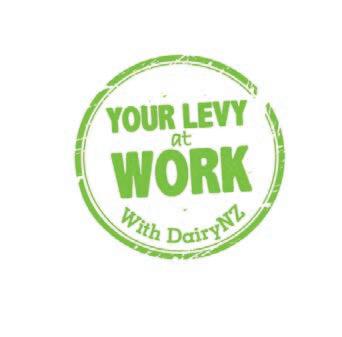
Although this summer is nearing its end, now is the time to check how your cows have coped and to kick start projects that will keep your cows cool next summer.
Take a moment to check in with your team. Ask them what they think could be improved for next summer, both for the comfort of the team and your cows.
On my farm we have switched to oncea-day milking, we give the girls access to our shadiest paddocks during the day and recently started including zinc in meals so they aren’t put off drinking the water.
But every summer I watch our water system struggle to keep up with the herd on the hottest days, and wish we’d installed some extra troughs when we had time during autumn and winter. The farming cycle inevitably takes over and adding troughs never makes it onto our winter priority list.
I’ve talked to lots of farmers who go through the same cycle of intending but never quite getting around to doing things. Our brains subconsciously prioritise the things that feel most important, urgent or rewarding at a particular time. Similar to how the RAM of a computer works, your brain has to let unimportant things go to have the capacity to handle the ‘important’ things.
For our water system, this means once the weather cools, the issue fades in importance and prominence, and my brain lets it fall out of my working memory.
For work that has to be done when it no longer feels urgent, we need to stop it falling off the priority list. Put it in the calendar with a reminder or book it in with someone who will do the work. Even better, we can look to get started now by taking the first step.
My first step is to decide where in the race the trough should go and then buy the trough. This will then prompt me to continue the work as we enter the autumn and winter months.
If you’re interested in altering your summer milking times or installing sprinklers, your first step might be to check out another farmer’s system or call a supplier. To start on a long-term shade plan, your first step might be to contact someone for advice, such as your dairy company. n


Providing extra water troughs on the farm can help cows cope with the dry, hot summer months.
with DairyNZ
MORE:
For more information visit http://www.dairynz. co.nz/heatstress

It took an amazing effort from everyone, and as a nation we have been proud of what we have achieved in the fight against covid-19.
As a result, we have returned to normal life and enjoyed the freedoms that are not being afforded to people around the world as the pandemic still has a firm grip globally. But no doubt everyone let out a collective groan when the Government recently announced new cases in the community and raised the alert levels.
And the ensuing chaos across
Auckland supermarkets has proven that many Aucklanders did not learn from last time.
They seem to have forgotten that the economy will keep on turning and farmers will still be producing the very food they were scrambling to buy.
Regardless of alert levels and lockdowns, farmers have continued fighting the good fight.
After the nationwide lockdown last year, agriculture and farmers emerged as heroes. Farmers kept the country going by producing food and earning the only export revenue coming into the country – that says a lot about the sector.
We have put in the hard-yards, but we should never become complacent just because new cases have dropped to single digits.
At the time of writing, the
Government has still not found the source of the latest community cases, which is concerning, but we will carry on regardless.
Thanks to Cynthia Boyde for sending in this stunning photograph of their farm in Waikato. She works in administration at the Matamata
Vet Clinic and describes herself as a weekend farmer who loves photography. She is often out and about with her camera capturing scenes on the farm.
Sonita
Like us: farmersweekly.co.nz
Follow us: @DairyFarmer15 Read us anywhere: farmersweekly.co.nz
Dairy Diary
March 2021
March 3 – DairyNZ
Wormwise is the national worm management strategy. It aims to help farmers and their advisors manage internal parasites. DairyNZ is supporting Beef & Lamb NZ to bring internal parasite expert Dave Robertson to Hokitika. This Lake Brunner event is cross-sector and will be relevant to both dairy, and sheep and beef farmers. Info at www.dairyevents.co.nz
March 4-5 – Northland Field Days
The largest agri-event in Dargaville, Northland, where there is something for everyone rural or urban. As well as hundreds of exhibitors showcasing the latest innovations, there is plenty of fun, food and entertainment for the family. https://northlandfielddays.co.nz/
March 5 – SMASH
As we move towards the end of summer, join us for a live online chat with Waikato farmer Jamie Haultain and AG360 farm consultant Wade Bell. They will discuss Jamie’s system switch to OAD, what are the current conditions on-farm, how mating panned out, how they are going to influence his plan for next season, and more. Info at www.smallerherds.co.nz
March 10 – DairyNZ
Southern Dairy Hub Field Day. Info at www.dwn.co.nz/events
March 10-11 – DairyNZ
West Coast Focus Farm Trust Field Day, Kowhitirangi and Mawheraiti This year we will be looking through the lens with an environmental focus on the farm system. Info at www.dairyevents.co.nz
March 18 – Owl Farm
Owl Farm Focus Day. Join us at Owl Farm using data to discuss management of the season-to-date, performance of summer crops, growing calves on chicory and relevant topics led by our team of technical experts, including Ballance. Info at www.owlfarm.nz/
March 18 – 20 Central District Field Days
A unique agriculture event where communities come together to connect, discover and experience the future of New Zealand’s primary industries in Feilding. https://www.cdfielddays.co.nz/
March 24 – SMASH
Let’s celebrate dairy, Lichfield. We have some of NZ’s best food producers in the Waikato, including Over the Moon Dairy. Come visit one of their suppliers, Bram Ebeling, have a gourmet feast with us, and hear about how Bram operates his farm to produce a high quality product. Info at www.smallerherds.co.nz
March 24-26 – South Island Agricultural Field Days
Over three days, the latest in rural technology, equipment and ideas from around the world will be on display in Kirwee. Info at https://www.siafd.co.nz/
S M T W T F S 1 2 3 4 5 6 7 8 9 10 11 12 13 14 15 16 17 18 19 20 21 22 23 24 25 26 27 28 29 30 31
March 25 – Dairy Industry Awards
Dairy Industry Awards Regional Awards dinner. Copthorne Hotel in Masterton. Come along and celebrate the best of the best in our region. Info at www.dairyindustryawards.co.nz/
March – Dairy Women’s Network
Make time for your people, various dates and locations. People are at the epicentre of our farm businesses, and ensuring employers and employees have strong relationships and a good work-life balance is key to the future of the industry. Moving the dial on the importance of attracting and retaining great people in the dairy industry is the focus of this workshop and webinar series. Info at www.dwn.co.nz/events
March – Rural Support
GoodYarn workshop, various dates and locations. Good Yarn is a hands-on workshop that will give you the practical tools and confidence to be able to talk to people in rural communities about mental health. This workshop is aimed at anyone living or working in a rural community and will cover tips for maintaining mental wellbeing. Info at www.rural-support.org.nz
March – LIC
MINDA roadshow, various dates and locations. LIC will be hitting the road from February to July 2021, holding free MINDA LIVE training sessions across the country. Info at www.events.humanitix.com/tours/minda-roadshow-2021
April – Dairy Women’s Network
DWN2021 ‘Step Up Together’ Conference in Waikato, Canterbury and Otago This year, we’re bringing our conference to you. Join us for one-day packed with plenty of opportunities for growth. From workshops and networking sessions, to just taking time out away from the farm, DWN2021 is a chance to fill your bucket and celebrate the role you play in the industry. Tickets are limited. Info at www.dwn.co.nz/events










